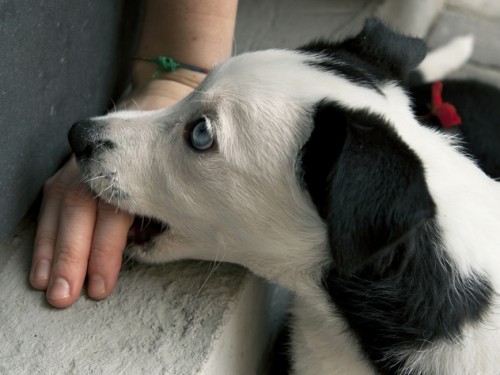How to Stop Dog Mouthing

What is Mouthing?
“Mouthing is when a dog puts his teeth and mouth over a person’s skin while using little or no pressure from his jaw, says dog trainer and expert Mikkel Becker onVetstreet.com. “It’s not to be mistaken for aggressive biting, which is done out of fear or frustration.”
While mouthing may not be an aggressive behavior, it’s still frustrating and your dog could unintentionally hurt or scare someone, or the behavior could escalate into a bite.
Certified pet behaviorist and author Amy Shojai suggests using a two-pronged approach to curbing your dog’s mouthing behavior, starting with teaching “bite inhibition.”
Bite Inhibition
“Bite inhibition is a dog’s ability to control the force of nipping and mouthing,” according to Vetstreet.com. “A dog who hasn’t learned bite inhibition doesn’t recognize the sensitivity of human skin, so the dog nips and mouths too hard, even when playing.”
Puppies and young dogs typically learn bite inhibition during play with other dogs, according to author and dog expert Jennifer Bridell. When dogs play, they frequently use their mouths. If one dog bites too hard, the bite victim yelps and stops playing. This usually gives the biting dog pause. This is how dogs learn to control the force of their bites. Biting too hard means play time stops, and no one wants that to happen.
Amy Shojai recommends people use a similar approach when trying to teach their dog bite inhibition . The basic idea is to reward the desired behavior and redirect or ignore the unwanted behavior. This training will take patience and time, and the best results might come with working with a Certified Professional Dog Trainer or behaviorist.
Teaching Bite Inhibition
People can use strategies similar to puppy play to teach their dogs bite inhibition:
Allow your dog to mouth you during playtime.
Continue playtime until he bites hard.
When he bites hard, let out a puppy-style yelp, and then promptly stop “playing” by letting your hand go limp.
This should cause your dog to pause. When he does, praise him enthusiastically and resume play as normal.
Repeating this over and over should help him get the message. If it doesn’t, you can introduce brief time outs by stopping play all together and walking away after you yelp. After 20 seconds or so of calm behavior from your cutie, return to him and play with him again. This helps teach him that painful play is “bad,” and gentle play is “good.” Gentle play buys him more playtime, while painful play ends it. No fun there.
Continue this sequence. You should notice your dog’s bites progressively getting gentler and gentler – until they have little to no pressure.
After you’ve helped your dog learn to be gentle with his mouth, it’s time to teach him not to mouth people at all.
Teach Your Dog to Stop Mouthing
The experts at Vetstreet.com recommend the following techniques for getting your dog to stop mouthing you and other people:
Substitute a toy or chew bone when your dog mouths.
When you stroke your dog, offer him tasty treats from your other hand to discourage mouthing you as you pet him.
Encourage non-tactile games like tug-of-war instead of rough play , such as wrestling.
Help your dog learn to manage his impulses through activities such as “Leave it” and “Sit.”
If your dog likes to “ambush” your feet or ankles, stop moving as soon as he does this. Then, distract him with a toy. When he grabs the toy, continue moving.
Provide your dog with regular playtime sessions alongside other well-behaved canines. This can tire him out and make him less interested in strenuous play (and therefore mouthing behaviors) with you.
« Common Dog Breeds for Degenerative Myelopathy Next Post
How to Brush Your Pet’s Teeth »





